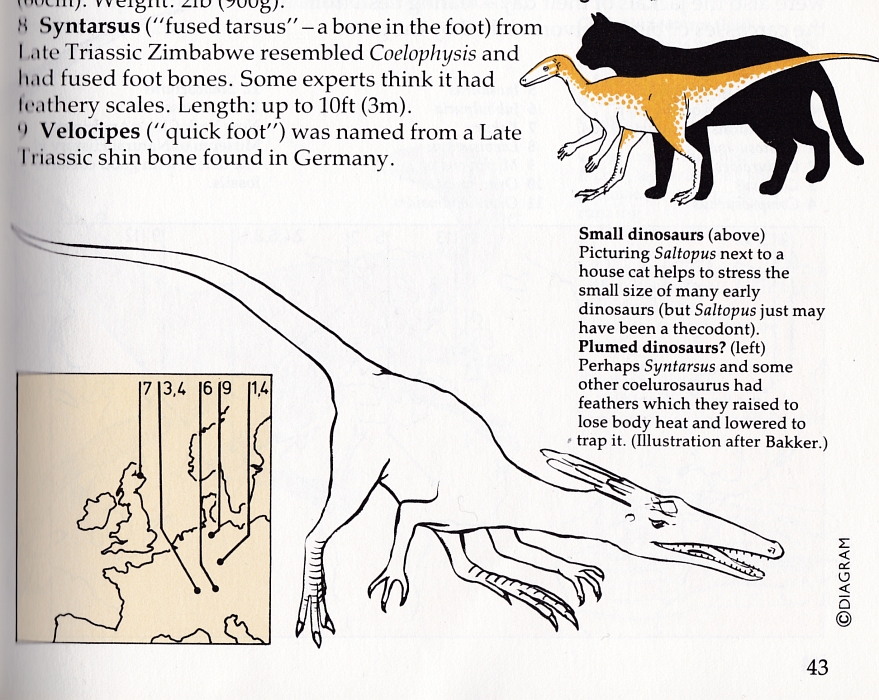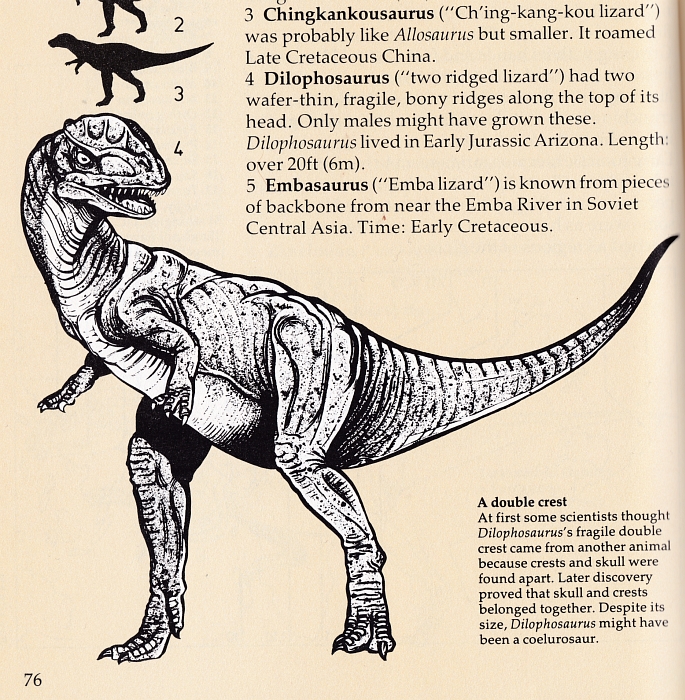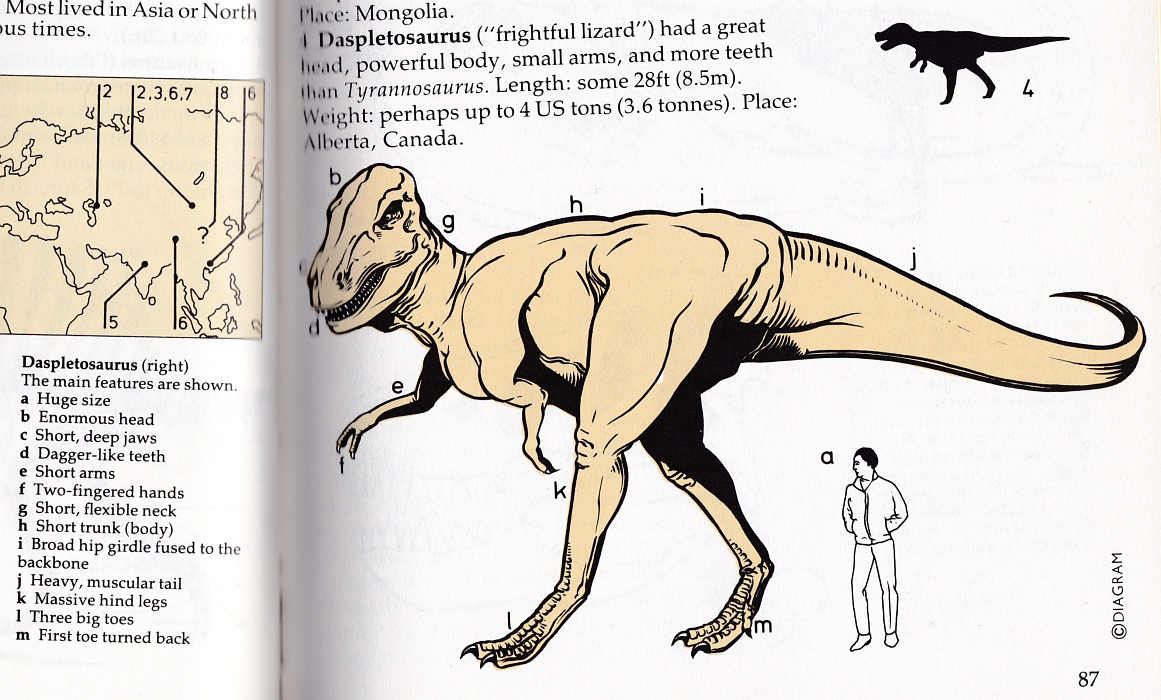As someone who reads this blog (hopefully on a regular basis), you’re no doubt familiar with Greg Paul’s Princeton Field Guide to Dinosaurs (aka Dinosaurs: a Field Guide), first published in 2010 with a second edition arriving in 2016. It’s arguably one of the most significant popular books about dinosaurs written this century, an attempt to catalogue dinosaur diversity in (almost) its entirety, complete with copious illustrations. Such a feat hasn’t been attempted too many times in the past (because it’s a lot of work), although one such instance came in 1983, when A Field Guide to Dinosaurs was published by Avon in the US. Written by David Lambert, illustrated by a variety of artists* and boasting an impressive array of big-name advisers (including Angela Milner and Ralph Molnar as General Consultants, John Ostrom, Dale Russell, José Bonaparte, and Alan Charig-whom-I-will-not-defame-ever-again), it’s certainly ambitious – perhaps a little too ambitious at times. According to the foreword, “dinosaur illustrations are based on reconstructions of skeletons in museums and scientific publications,” which I suppose they were, in a sense…but more on that later.

For a book that was trying to be thoroughly modern, it’s odd that the cover is so screamingly retro. There’s a sauropod in a swamp, anachronistic Pterodactylus-like pterosaurs swooping over the heads of Late Cretaceous dinosaurs, and a tyrannosaur and hadrosaur (carcass) that couldn’t look more Burianesque if the latter had toothmarks in its flesh that spelled out ‘ZDENEK’. That said, it’s quite beautifully painted, and that tyrannosaur doesn’t half have a wicked glint in his eye. The artist was one Sy Barlowe, natural history artist and father of Wayne Barlowe, who’d go on to paint a few dinosaurs himself (with stunning results).

Significantly, Barlowe’s piece is the only full-colour illustration to appear, in spite of what’s advertised on the cover; the majority of pieces in the field guide proper are monochrome, with splashes of yellowish-orange here and there (as demonstrated by Saltopus in the above illustration). The book begins with the usual preamble about what dinosaurs were and where they came from, before moving on to examining different dinosaur groups. This is where it becomes clear that dinosaur taxonomy in the early 1980s was still something of a mess, although we’ll put that aside for now. Instead, let us admire this Bakker-style Syntarsus/Megapnosaurus/Coelophysis, complete with feathery head crest and – shocker! – a credit to Bakker. Hooray! Of course, plenty of other artists have their work, er, referenced in this book, but aren’t credited in the same way. Perhaps Bakker’s beard was too intimidating, or perhaps the idea was to make it clear who was behind such an irresponsible degree of speculation. [UPDATE: As Mike Keesey points out in the comments, it was Sarah Landry who actually drew the original. Apologies!]

Whatever the case, where other artists are obviously copied, they aren’t so credited. So, there’s no ‘after McLoughlin’ attached to this illustration of Coelurus, which is based on John McLoughlin’s illustration of Ornitholestes (which he synonymised with Coelurus) in his book Archosauria – except here, McLoughlin’s remarkably prescient fuzzy pelt is replaced with a leathery, reptilian hide. Clearly, that was a bit of silly speculation too far for the Field Guide. The skin is very nicely detailed, mind you, and those birdlike tarsal scutes are telling. But, with the benefit of hindsight, that someone would take such a far-sighted illustration and produce a more conservative knock-off is rather amusing.
You’ll note also the types of animals that make it into this book – Sinocoelurus, named from four teeth. Teinurosaurus, named from a single caudal vertebra (now lost). Now that’s dedication. Then again, they do both have Wikipedia pages.

This Stenonychosaurus looks rather familiar too, although I can’t quite place the original artist (Ely Kish?). It does have the sinister-looking slit pupils of the famous Dale Russell/Ron Seguin sculpture, which were quite understandably copied frequently by artists in the 1980s and ’90s when illustrating this animal and its close relatives. I must admit, though, that I mostly included this page because hey, look, Dinosauroid! There he is, our old friend. I do enjoy the fact that Russell has become “Canadian paleontologists”. Wasn’t Bakker namechecked for his unusual hypothesis earlier on? Ah yes, but think of him bursting angrily into your office, his enormous hat casting a shadow over the room, bellowing from deep within his mighty beard to give him the credit he deserves in your pansy-ass dinosaur book. And it’s pronounced BAH-ker.

Remember when Oviraptor often had a mane? It’s a meme that I demand be resurrected, albeit with more extensive feathering over the rest of the body than is shown above, of course. Such was the prevalence of this trope back in the day, I’ve actually forgotten who started it (so if you know, do leave a comment). Although a little spindly-limbed, the fine detail on this piece is very pleasing; achieved through stippling and expert shading, it’s a good demonstration of how stylisation can make a reconstruction seem more lifelike than attempts at strict realism.
You may be wondering about the flamingo head. In a nearby caption, Lambert writes that “Oviraptor‘s short, deep skull (A) looks like no other known dinosaur’s, yet surprisingly resembles that of a flamingo (B)”. It’s a shame, therefore, that we aren’t treated to a reconstruction of a filter-feeding, pink Oviraptor, in place of the more conventional maned egg thief. That would have been a treat.

A little more on the Field Guide‘s taxonomy, now. As you’ve probably guessed, all of the animals heretofore mentioned are gathered under the ‘coelurosaur’ umbrella, while any larger theropods are grouped together as CARNOSAURS. Back then, it was obligatory to write CARNOSAURS in capital letters, for CARNOSAURIA represented the absolute coolest unnatural grouping of distantly related awesome, colossal predators the world had ever seen. (Nowadays, it’s just a bunch of allosaurs or something.) In any case, Dilophosaurus is among the first to pop up in this chapter, although Lambert notes that “despite its size, Dilophosaurus might have been a coelurosaur”. Har, har. I’m quite sure that this unusually robust-looking ‘megalosaur’ version of Dilophosaurus is based on a Peter Snowball illustration, although I’m having trouble locating the original. In truth, I’m not sure there even is one – this does also strongly resemble a mirrored Snowball Megalosaurus with added head crests.

As far as Megalosaurus itself goes, it naturally receives far more attention than it would in a similar book today, being treated to a large, double-page illustration with lots of cool gory stuff going on. When compared with the earlier illustrations of ‘coelurosaurs’, this is a much more convincing-looking beast. It’s suitably big and bulky-looking (although not as much as, say, a tyrannosaurid), its highly birdlike legs sporting powerful, bulging muscles. This view of a large theropod as an active, lithe creature is quite typical of the Dino Renaissance-era approach of much of the book, which is nothing like as retrograde as its cover might suggest. It also rather reminds me of the work of William Stout, in the best way. (If one of you points out that this has been copied from Stout, I’ll be proper annoyed.)
Yes, the phrase “tiny big toe” annoys me too.

Being so well known, it’s only natural that Allosaurus is also treated to a double-page spread, comparing its mighty bulk with a rubbish old car. (In that thing, they’ve no hope of outrunning any giant theropods.) It’s a fine illustration, although it is, again, highly reminiscent of McLoughlin’s reconstruction of the animal from Archosauria, albeit mirrored. The artist has also added the small horns on the animal’s skull, which McLoughlin strangely missed. This does mean that this reconstruction is very up-to-date for 1983, a time when artists still leaned on the more upright and bloated reconstructions of the pre-Renaissance era. If anything, it might be a little too skinny. Speaking of which…

…Here’s a rather thin Daspletosaurus, clearly based on a painting by Ely Kish, who (as it happens) worked closely with certain ‘Canadian palaeontologists’. I don’t have a great deal to say on this one, other than to point out that it’s labelled as having “three big toes” which, given the terminology used previously in the book, is rather confusing.

And finally…remember when nobody knew what on Earth to make of therizinosaurs? Say ‘Segnosaurus‘ to me, and I still think of John Sibbick’s brightly-coloured, web-footed, fish-eating weirdo. The segnosaur page in the Field Guide also hints at fish-eating habits, although only the head of the animal is restored (in a fashion very reminiscent of William Stout’s work; it might be a copy). The opposite page to this one deals with therizinosaurs as they were then understood, although with such scanty remains to work with, there isn’t a great deal to look at. Still, I love these early attempts at restoring poorly-known animals – they’re always useful reminders as to just how much we could still be getting wrong…
The Field Guide will return!
*Joe Robinson, Graham Rosewarne, Sean Gilbert, Ashley Haddock, Brian Hewson, Richard Hummerstone, Janos Marffy, Eitetsu Nozawa, Max Rutherford and Jerry Watkiss. Mark Evans is credited as Art Director, and Neil Coplestone as Art Assistant.






9 Comments
tmkeesey
November 5, 2019 at 1:55 pmThis was THE BOOK for me as a kid, introducing dinosaurs in all their diversity. The Dinosauricon was an attempt to do something like this for the web, and the core idea of PhyloPic goes back to the silhouettes in this book (as well as Safari Cards).
A note about “Bakker’s” Megapnosaurus — it is actually Sarah Landry’s: http://dinogoss.blogspot.com/2016/05/the-first-feathered-dinosaurs-in-art.html
Niels Hazeborg
November 5, 2019 at 2:09 pmhttp://babbletrish.blogspot.com/2011/02/syntarsus-and-his-badass-mohawk.html
Marc Vincent
November 5, 2019 at 2:14 pmExcuse my ignorance, and thanks for the comment – I’ve updated the post.
Niels Hazeborg
November 5, 2019 at 1:56 pmThat Dilo absolutely looks familiar! Might have been in that Dinosaurs magazine? Also: Torvosaurus as a “harmless scavenger”. Was that ever a meme, before Horner made it about T. rex?
Gary Campbell
November 5, 2019 at 2:56 pmAnother great post! The book states that it is ‘the first complete guide to every dinosaur now known’. Not quite. As far as I know that honour should go to Glut’s 1972 Dinosaur Dictionary.
Timur Sivgin
November 6, 2019 at 2:25 pmNot only did they copy McLoughlin‘s Ornitholestes, they also reproduced his “Great Fossil Lizard“ reconstruction. While we‘re on the topic of McLoughlin, ever thought about reviewing his other book Synapsida? Of course it‘s not about dinosaurs but it still features a lot of interesting paleoart of early synapsids (and a bit of strange cold war era humor).
Benjamin Chandler
November 13, 2019 at 8:22 amThis book and Gluts pair of dictionaries were my childhood dinosaur Bibles. I pored over the listings of beasts, no matter how obscure and fragmentary. I loved the Stout-like illustrations in this one, too. All those veins and guts along the belly…
Ozraptor4
November 13, 2019 at 11:26 am“It also rather reminds me of the work of William Stout, in the best way. (If one of you points out that this has been copied from Stout, I’ll be proper annoyed.)”
As you wish = https://i.imgur.com/iWcT3V8.jpg
Jens Kosch
January 28, 2020 at 5:39 pmThis was the first dinosaur book I ever got (in 1989 in a German translation as “Alles über die Dinosaurer” and with a different cover that was even more “pre-renaissance”: https://images.booklooker.de/x/00wi8z/David-Lambert+Alles-%C3%BCber-die-Dinosaurier.jpg). It stayed my favorite dinosaur book until I got a copy of Hartmut Haubold’s “Die Dinosaurier” a few years later (which was packed full with cladograms, and in-text references to primary literature, bridging the gap between a review paper and a popular science book in a way I have rarely seen since [maybe Matt Wedel’sand Mark Hallett’s “The Sauropod Dinosaurs”comes close; but in this golden age it seems impossible to make a single volume book that approaches the subject of dinosaur paleontology in an overview in such a depth that closely approximates the current understanding of almost all relevant topics in the scientific literature as “Die Dinosaurier” did for its time when first published in 1989]).